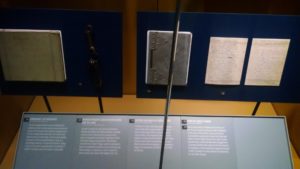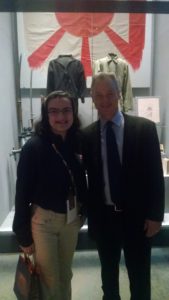Nearly a year ago, Sarah Bowden, a student at Baltimore Polytechnic Institute, traveled to New Orleans to represent Maryland in the grand opening of a new exhibit at the National World War II Museum. Sarah was selected for this honor as a result of her participation in Maryland History Day in 2015 and she kept a travel diary of her experience.
As we mark the 75th anniversary of the bombing of Pearl Harbor, which led to the United States’ entry into World War II, we are sharing some excerpts from Sarah’s diary.
10 December 2015
TRIP: to New Orleans for grand opening of Road to Tokyo Pavilion at National World War II Museum!
1:13 PM–
So, for any uninformed who are reading this, when I did NHD [National History Day], my project was chosen as an exceptional WWII project, and I was chosen as the MD representative to go to New Orleans for said purpose at beginning.
I am extremely excited and honored to be part of this event. I mean, just to think I’m witnessing the OPENING of a MUSEUM! Now when I’m older, I can tell kids who see the Road to Tokyo pavilion, “I was at the grand opening!” I’ve also never been to the museum before. Or New Orleans. But I’ve really wanted to go and soak up some French culture. J’aime bien le français! [I really like French!]
I also have a list of foods and restaurants to try. When I told people where I was going, the most common response was, “Oh, you need to try _____!” We have:
- jambalaya
- pralines
- beignets
- crayfish
- Eat New Orleans (French Quarter)
- Sucré
- Café Beignet
We got to New Orleans 5:00 CST. By the time we got to the hotel and checked in, the others [students from the other states selected for the ceremony] had already left the hotel, so Mom and I made our way to the museum solo.
The museum’s closed to the public right now, so we state reps (that’s my new name for me and the other kids) and our chaperones got to tour part of it ourselves. Including a “private” self-guided tour of Road to Tokyo!
I’ll be honest: I’m a pacifist, so I always get kind of depressed when I learn about Americans going to war, even though some of my family members have served in the military. But the pavilion was really well done and very interesting. Lots of artifacts from uniforms to guns to forbidden diaries (the Navy forbade diaries in WWII, though some people secretly kept one. Mom told me, “Oh, no diaries! No Navy for you then, Sarah!”). And there were these interactive stations where you could hear oral histories and see artifacts and photos.
There’s apparently this thing where you can get a “dog tag” and scan it at these stations to learn a specific WWII person’s story, and I wished I had a dog tag because it looked interesting.
But the part that really got to me was near the end: US bombings of Japan. I stood in that big room with artifacts from the bomber planes and video footage of the mushroom cloud and this fragile music in the background and…it resonated with me. To the extent that I felt like some of it was still inside me when I walked out.

There were also little things that stuck with me: a video of a soldier running away as his ship got hit. Baseball bat and glove used by soldiers in the Pacific. A picture of a little Chinese baby who survived the Shanghai bombing. A “Jap” (as the US called them) who committed suicide by pushing a grenade into his face, now a black smudge. A diary (Thomas “Cotton” Jones’s) which had on one page a request that if the diary be found, it be returned to Laura Mae Davis (I think that was her name), his sweetheart. A flamethrower. I didn’t know they had them in WWII.
I learned about the Battle of Midway and life in Guadalcanal, a.k.a. Green Hell. That area was designed to look like a rainforest, complete with guns and artillery hidden in the grass. They had footage and recording played on tarps, and I vividly remember one voice– not word for word, but something like, “We were young. We were stupid. We didn’t know what war was like.”
11 December 2015
8:30 AM CST– I’m in line with my state flag and all the other state reps with theirs. We went over our procession and recession: we walk in with our flags at the beginning and put it in a stand, then sit. At the end, we walk out with our flag.
I’m super excited! Some people may be bored at the idea of sitting through a long official ceremony, but not me! This is history, baby! Woo-hoo!!
11:53 CST– What a ceremony!
We all processed in with our flags, and everyone stood and clapped for us and videotaped us.

Gary Sinise gave a welcome and they did the color guard and national anthem. In honor of my Baltimore home, I was sure to (quietly) exclaim “Oh!” at the appropriate time.
Next they showed a video on the Merchant Marines in honor of their new exhibit. Then there was another video about “the War in the Pacific.” I never knew the red dot on Japan’s flag was the rising sun. That’s kind of cool. After that, General Mark A. Milley, who fought in the Middle East, talked about what the war meant to us. I was very touched when he talked about what we learned and mentioned, indirectly, that even army guys don’t want to have war. It was nice to hear that and remember it. He also talked about how war requires effort from all of us, not just the military.
Then a veteran [Paul Hilliard] got to speak. He was actually really funny. He mentioned, “My trip around the Pacific, paid for by the government. . .” I was surprised at his ability to laugh about something that must have been awful.
Next, a student ambassador named Maddie talked about her experiences as an ambassador and preserving stories for younger generations. I remember one quote she said: (Rudyard Kipling) “If history were told as stories, it would never be forgotten.”
[As I type this, I’ve decided perhaps instead of making kids read boring textbooks, teachers should take them to museums and battlefields and historic places and have them learn there. That would be much more effective, and much more fun.]
Gotta go, be back soon.
The opinions expressed by guest contributors to the Maryland Humanities blog do not necessarily reflect the position or policy of Maryland Humanities and/or any of its sponsors, partners, or funders. No official endorsement by any of these institutions should be inferred.

